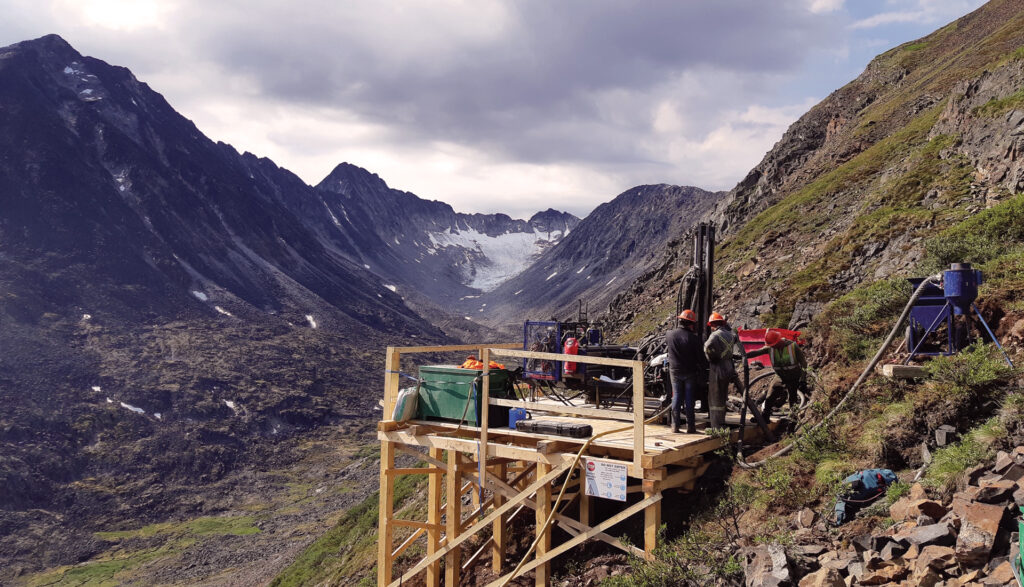Northwest Territories
Mining and Mineral Exploration Overview

In spite of a poor year for rough diamond sales globally, diamond mining continues to provide a foundation for the NWT economy. The Gahcho Kué mine, which has been operating with better production than forecast, announced the discovery of the diamondiferous Wilson kimberlite within the current mine plan area. Consistently high estimates for future zinc demand have encouraged both the rejuvenation of Pine Point by Osisko Metals Inc. and NorZinc Ltd.’s efforts to bring Prairie Creek into production. Gold prices have been buoyed by a safe-haven sentiment driven by concerns over economic growth, tariffs and trade wars with China. Advanced projects have benefitted from an improving investment climate encouraging ongoing exploration by Nighthawk Gold Corp. and TerraX Minerals Inc.
However, many smaller projects, particularly projects targeting green energy and battery technologies, were suspended as the companies were not able to raise sufficient funds in the investment market. A notable exception was the reactivation of Avalon’s Nechalacho project with an infusion of resources from Cheetah Resources of Australia.
One of the indicators of exploration activity – claims staked versus lapsed – started to fall slightly. In the first three quarters of 2019, 120 claims covering 45,000 Ha were added but a nearly equivalent area 55,000 Ha in 85 claims and leases were cancelled. There are 37 active Prospecting Permits this year. New staking included large areas in the Mackenzie Mountains, additional ground at Pine Point, a re-staking of claims in the Lac de Gras region and expansion of claims in the Yellowknife area.
Diamond Mining
Gahcho Kué Mine
The Gahcho Kué mine, which is 51 per cent owned by the De Beers group of companies and 49 per cent owned by Mountain Province Diamonds, had production results for the first half of 2019 that were slightly ahead of plan with over 20 million total tonnes mined. In H1 2019, the plant has treated 1,753,323 tonnes and produced over 3.3 million carats at an average grade of 1.89 carats per tonne. Process plant modifications enabled the plant to treat more ore which has resulted in the loss of very small, lower value diamonds while increasing the number of larger more-valuable diamonds recovered with the increased tonnage.
On June 19, the discovery of the diamondiferous Wilson kimberlite was announced. The Wilson kimberlite is located roughly 200 meters east of the Tuzo kimberlite, well within the existing open pit mine plan. It is named after Alice Evelyn Wilson (1881-1964),
who is recognized as Canada’s first female geologist.
Diavik Diamond Mine
During the first half of the year Diavik Diamond Mine, which is 60 per cent owned by Rio Tinto and 40 per cent owned by Dominion Diamond (part of the Washington Companies), processed 1,291,000 tonnes of ore and recovered 3,663,000 carats. Diavik carats, recovered in the second quarter, were three per cent higher than the second quarter of 2018 due to slightly higher grades and ore processing throughput.
Ekati Diamond Mine
The Ekati Diamond Mine is owned and operated Dominion Diamond Mines ULC There is no publically available production data at this time.
Exploration
Diamonds
The Lac de Gras project, a joint venture between Dominion Diamond Mines (79 per cent) and North Arrow Minerals Inc. (21 per cent) covers 147,200 hectares south of Lac de Gras. This spring, a ground geophysics program consisting of three methods, including magnetic (11 grids; 465 line-km), gravity (9 grids; 2,100 stations) and OhmMapper resistivity (5 grids; 90 line-km) surveys was carried out. All of the surveyed target areas were associated with anomalous kimberlite indicator mineral results from till samples collected during prior reverse circulation overburden drilling programs.During the follow-up drilling, kimberlite was discovered on the first drill hole at a depth of approximately 40m. The drilling was part of a summer work program scheduled to also include LIDAR surveying, prospecting, till suitability mapping and sampling.
The Loki project, wholly owned by North Arrow Minerals Inc., is located in the Lac de Gras region of the NWT, approximately 30 km southwest, and 24 km west of the Ekati and Diavik diamond mines, respectively, and immediately adjacent to the west of North Arrow’s LDG Joint Venture Diamond Project with Dominion Diamond Mines. Previous exploration work in 2018 led to the discovery of a new kimberlite on the Loki property.
This summer, a three-week exploration program consisting of prospecting, till sampling, and ground geophysics was carried out to confirm and prioritize targets for follow up exploration drilling in the winter of 2020. This exploration is supported, in part, by a grant from the Government of the Northwest Territories (GNWT) Mining Incentive Program.
The Diagras property is a joint venture between Margaret Lake Diamonds (60 per cent) and Arctic Star Exploration Corp. (40 per cent) in the Lac de Gras region of the NWT. Land tenure at Diagras totals 22,595 hectares within 31 mineral claims with a total of 23 known kimberlites. A spring exploration program was carried out in 2019 consisting of ground Gravity, Magnetic and Electromagnetic (EM) surveys focused around historically identified kimberlites as well as other airborne geophysical anomalies with kimberlite like signatures. The application of detailed, modern ground geophysical technique defined possible additional kimberlite(s) or kimberlite phases not identified by previous explorers, and follow up drilling is planned for spring 2020. The work has been funded in part by grants from the GNWT’s Mining Incentive Program.
The Seahorse project is located approximate 775 km NE of Yellowknife and 190 km north of Great Bear Lake. This project is a joint venture between Talmora Diamond Inc. and Olivut Resources Ltd. (operator, which can earn up to a 50 per cent interest).
This spring a helimag geophysical program was conducted over multiple anomalies previously identified from regional geophysics. Preliminary results confirmed targets and provided detail that aided the summer drilling program. During the summer, a reverse circulation drill program with a heli-portable rig tested geophysical anomalies. Downhole samples were collected and sent for lab analysis.
Heavy mineral sampling took place on the 11,000 hectares ZIP Diamond project (wholly-owned by GGL Resources Corp.) roughly 250 km N-NE of Yellowknife. The ZIP camp also hosted researchers from the Simon Fraser and Carleton Universities and the NWT Geological Survey who carried out regional heavy mineral sampling and surficial geological mapping programs to better understand the diversity of indicator mineral transport systems and till sampling suitability in the Slave Geological Province in areas surrounding the ZIP property.
The Kennady North project, located approximately 10 km northeast of the Gahcho Kué Mine, is owned by Mountain Province Diamonds Inc. and includes the Faraday 2, Faraday 1-3, and Kelvin kimberlites. An updated mineral resource for the Faraday 2 kimberlite was provided, which is now deemed to contain 5.45 million carats in 2.07 million tons of kimberlite, with an overall grade of 2.63 carats per tonne at an average value of US$140 per carat. This represents a 49 per cent increase in tonnage and a 74 per cent increase in total carats from previous estimates.
The winter 2019 exploration program drill-tested exploration targets located three to four km southwest of the Gahcho Kué Mine. The drilling of priority targets was hindered by flight-restrictive weather for the helicopter-supported drill program. Only five drill holes, totaling 917 metres of the 2,000-metre program were completed, and no kimberlite was intersected. The untested targets will be reviewed for discovery potential and reprioritized along with other targets in the Kelvin-Faraday Corridor located northeast of Gahcho Kué.
Gold
Initially, Nighthawk Resource Corp. announced a $10 million plan to complete 25,000 metres of drilling in 2019 at Colomac and satellite targets, and accompanying regional mapping and prospecting on its 899 sq.-km Indin Lake Gold Project. The budget was increased to $13 million for 35,000 metres of drilling. At Colomac, the program tested deeper portions of Zones 1.5 and 3.5, as well as between Zone 3.5 and the southern part of Zone 2.0.
All 2019 drill holes reported thus far (12,824 metres), have intersected mineralization. Initial results from Zone 1.5 were exciting, including hole C19-08 which intersected 56.00 metres of 13.49 g/t Au (35.00 metres true width), including 10.00 metres of 53.57 g/t Au. Additional drilling along the sill tested previous intersections to greater depths. Of note, drilling at Zone 2.0 returned 60.75 metres grading 2.61 g/t Au (C19-19) and 56.25 metres of 2.76 g/t Au (hole C19-24).
The regional exploration program followed last year’s success which identified new gold showings while also testing historical occurrences. Drilling commenced at Treasure Island with holes T19-01 and T19-01B with both holes intersected mineralization;
T19-01 returning 6.25 metres of 12.08 g/t Au, while the steeper hole T19-01B reported an upper intersection of 27.25 metres of 1.41 g/t Au, and a deeper intersect of 6.50 metres of 10.20 g/t Au. While the current drilling has extended the zone to the west of the Main Zone and to greater depths, there remains a corridor of approximately four km to Laurie Lake showings that remains to be explored.
TerraX Minerals Inc. expanded its land holdings to 783 sq.-km with claim staking and property acquisitions. As part of the exploration efforts, four priority targets were announced. A review using historical data and 2019 re-assays of historical core, has led to a concentrated effort to expand the deposits at Crestaurum and Sam Otto, as well as advancing the North Giant Extension within the Barney Deformation Corridor.
The Sam Otto drilling of six holes (1,182 metres) resulted in an extension of gold mineralization by an additional 600 metres of strike. Highlights from the Sam Otto South zone include 7 metres of 2.93 g/t gold and 14 metres of 1.36 g/t gold. These results combined with the 2018 results show that the Sam Otto South zone extends for 1.2 kilometers with gold mineralization having been found over a distance of 2.5 km along the Sam Otto structural corridor.
Following the Sam Otto drilling, the Berry Hill zone, within the Barney Deformation Corridor was drill tested to follow up on historical drill results and surface sampling. Another 2,500 metres of drilling is forecast for the fall on the Crestaurum Structure.
At press time, TerraX had announced its first mineral resource estimate of 735,000 inferred ounces of gold.
Sixty North Gold Mining trenched their Mon Gold property located 45 km north of Yellowknife. A total of six trenches over 120 metres were blasted into the 5656 zone that was discovered by prospectors following-up on a biogeochemical anomaly. Grab samples in this zone graded up to 2.30 g/t Au, 360 g/t Ag, 3.83 per cent Pb, and 1.94 per cent Zn. Several massive, semi-massive, and heavily disseminated sulphide zones were encountered over true widths between 0.4 and 2.1 metres containing tetrahedrite, galena, sphalerite, pyrrhotite, chalcopyrite, arsenopyrite, and pyrite.
On the West Mafic trend, an additional trench was blasted into a rusty felsic volcanic containing irregular minor quartz veining. Results have not been announced.
Evrim Resources Corp. announced exploration results from their Astro Project, a new gold discovery within a 10-km-long structural corridor along the Yukon-NWT border. Work started in June and included a mag/VTEM survey, detailed geologic mapping, chip-channel and talus-fines sampling and an 11-hole reverse-circulation drilling program.
The helicopter magnetics/VTEM survey outlined structurally controlled magnetic anomalies coinciding with surface showings and gold-in-soil anomalies over a strike length of 9.5 km. At the Radio prospect, chip-channel sampling returned 3.3 g/t gold over 26 metres (including 12.5 g/t gold over six metres) across magnetite-pyrite skarn and overlying siltstone. Drill hole RAD19-01 intersected 1.36 g/t gold over 10.7 metres. At the Microwave prospect, chip sampling returned 3.6 g/t gold over 18 metres and 3.1 g/t gold over eight metres from trenches. At a new discovery, Ultraviolet, one km southeast of the Radio prospect, chip channels returned 6.1 g/t gold over 4.0 metres. A drill hole GAM19-01, tested the northern end of a soil anomaly returned 1.04 g/t gold over 6.1 metres.
The RC drilling program tested the stratigraphy in proximity to prospects and identified several new gold-bearing zones, including an interval of mineralized granodiorite east of Radio and silicified siltstone in a range-bounding fault at Gamma suggesting an extensive gold system along the eastern margin of the Border pluton.
Lithium
Far Resources signed an option agreement with 92 Resources on the Hidden Lake project and drilled 1,079 metres in 10 holes on four lithium-bearing spodumene pegmatites. Results indicate each of the pegmatite dykes, HL-001 through HL-003 and D-12, included high-grade Li2O assays of 1.0 per cent to 2.0 per cent over widths between 2.0 m and 9.2 m. Mineralogical evaluation and metallurgical testing of samples from the Hidden Lake pegmatites by SGS Mineral Services (Vancouver) indicates a lithium concentrate of >6 per cent Li2O with a recovery of >80 per cent are achievable. These results indicate the Hidden Lake pegmatites can be treated using standard industry practices for spodumene beneficiation.
Zinc and Lead
NorZinc Ltd., formerly Canadian Zinc, continues to work on the permitting process for the all-season road to the Prairie Creek Mine site. The deposit has a proven and probable reserve of 8.1 million tonnes of 8.6 per cent zinc, 8.1 per cent lead and 3.6 ounces per ton silver. NorZinc also conducted pre-construction and cleanup work on the mine site. Resource Capital Fund (RCF VI CAD LLC) has agreed to purchase a 1 per cent royalty on Prairie Creek Mine for C$8 million to provide funding through the completion of permitting of the project.
Osisko Metals had a substantive exploration and drilling program at the Pine Point Project this year, centred on an airborne gravity gradiometry survey which was completed and is awaiting data processing. The intent is to use the LIDAR high-resolution topographic survey flown in 2018 to identify structural controls and subtle circular collapse breccia structures in conjunction with gravity anomalies that could be indicative of prismatic deposits. Another major activity was to complete a compilation of the historical drill hole data into a new database. This effort identified over 100 drill holes with significant mineralization, indicative of near-surface mineralizing systems that were not pursued by previous operators. The aim is to increase the resource base beyond the new Mineral Resource Estimate of 38.4 Mt grading 6.58 per cent ZnEq along the 60-km-long system of lead-zinc mineralization. Osisko Metals has also launched a 5,000-metre drill program. This program will test some of the new targets as well as examine the potential for mineralization in the deeper underlying Pine Point Formation. The aim is to identify additional high grade “Prismatic” mineralization which manifests as vertically continuous breccia pipes associated with regional and secondary faults, in contrast to horizontal “Tabular” deposits that are stratiform, controlled by more permeable geological formations.
Other Metals
Fortune Minerals continues to work on refining the economic parameters on its NICO deposit. Work has concluded that a 4,650 tonne/day milling rate was optimum to produce the best balance between economies of scale and capital costs while focusing on a smaller open pit with higher cobalt and gold grades. Economic modelling has also confirmed that using a mining strategy of combined open pit and underground mining in the early years of the mine life will improve project economics.
Regency Gold purchased Vanadium North Resources Inc. that holds the Valley of Vanadium project in the NWT. The 9,600-hectare project comprises wholly-owned claims in addition to an option to acquire 100 per cent of mining claims owned by Strategic Metals Ltd. The property previously known as the Van project encompasses a major sediment-hosted Vanadium prospect that has not seen focused exploration since 1985.
Improvements in the price of neodymium and praseodymium oxides prompted Avalon Advanced Materials to reactivate their postponed Nechalacho project southeast of Yellowknife. Fieldwork began in July through an agreement with Cheetah Resources Pty Ltd. to begin work on the T-Zone rare earths resource.
Re-logging and sampling of historic drill core was accompanied by the shipment of a stockpiled bulk sample from the T-Zone for metallurgical process test work. This project has the potential for a start-up operation exploiting high-grade, easily accessible near-surface mineralisation from the North T-Zone rather than focusing on the larger Upper Lake Zone. A drill was also mobilized for an in-fill drilling program.
Cheetah Resources has entered into an agreement with Avalon Advanced Materials to acquire a portion of the resources of the Thor Lake project with the company acquiring mineral rights to all mineralisation between the surface and a depth of 150 metres above sea level. Vital Metals Limited announced that it would acquire Cheetah Resources and provided a loan facility of up to $4,500,000 (Austrailian) to fund Cheetah’s obligations arising under the Avalon Agreement. Approximately $500,000 of the funds are to be utilised to accelerate development of the Thor Lake project including the conversion of the existing 43-101 resource to JORC 2012 standards, additional exploration drilling on the North T Zone and bench-scale test work on ore sorting and leaching.
Other Highlights
The Mineral Resources Act was passed by the Northwest Territories’ Legislative Assembly in September establishing the NWT’s first-ever stand-alone Act governing mining in the territory.
In 2019-2020, $984,027 in Mining Incentive Program (MIP) funding has been allocated to 19 exploration projects, including 12 prospectors and seven companies. Since the MIP was implemented in 2014, recipients have invested over $11 million in NWT exploration projects. MN

